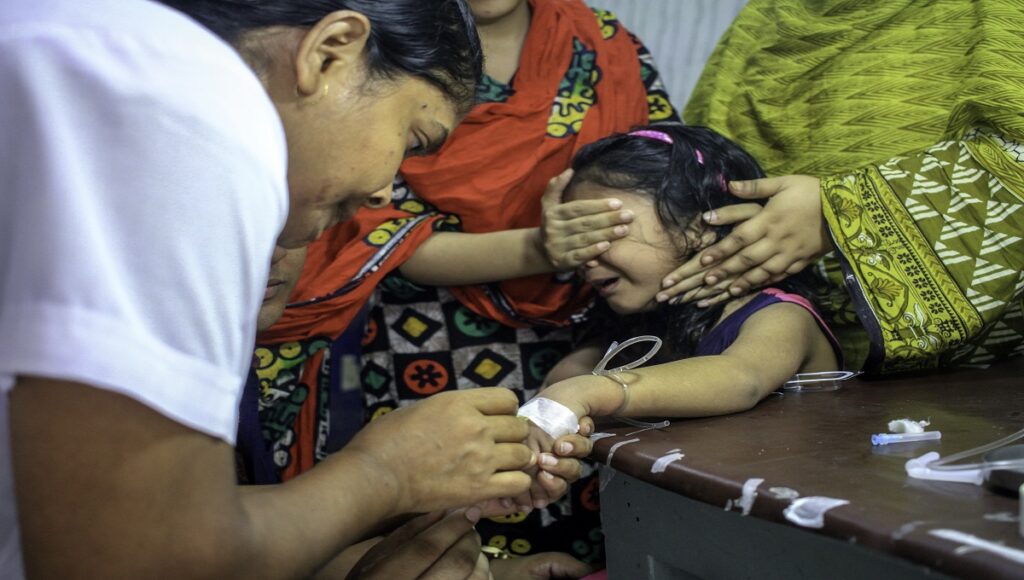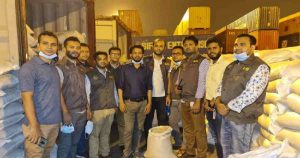Mostafa Kamal Majumder
A tiny kid of two years carried in the lap was telling his father, ‘I will not be given this’ as another child was screaming as a paramedic at a reputed private hospital was piercing a needle to collect blood to test for dengue. The pathological laboratory at the hospital in Mirpur 11 Section was working overtime to tackle the huge rush of people who ran there for the medical examination as they were suffering from fever. One-third of the people waiting in the room beside the pathology room were children. Being asked one paramedic said this was not a weekend day crowd on Saturday. The crowd is the same every day and there is no sign of diminishing the incoming of city dwellers to check for their medical status. Some of them were talking normally with smiles on their faces, some others in a visibly tense state as the dengue disease had no specific cure.
The paramedic said we are overworked. It’s 10 pm and bed-time for many people. The rush is still there. For the last one month, the heavy rush has become normal. It starts at 9 am in the morning and ends at around 11-30. ‘We refuse tests to none, she said, with a sign of contentment in her face.
The tiny tot who was telling his father that he will not be pierced syringe needle had his mother and a sibling apparently two years older than him and sat near a blood-sample collection table, awaiting the preparations by another paramedic to attend him. They smiled at the innocent boy but looked worried that their boys had caught fever which is not a good thing at a time when dengue was an epidemic in the Dhaka Metropolitan City of about 20 million people. The worst thing about the outbreak before the Eid Festival was that dengue virus-infected people from Dhaka and Chittagong spread to all the remaining 62 districts cramming their hospital facilities and making the remaining population scared. At least a dozen deaths were reported from the districts.
Before the August 12, Eid-ul-Adha celebrated in Bangladesh, every day about 2400 new dengue patients were getting admitted to different hospitals in the capital and elsewhere over the country. Bangladesh had a good healthcare network extending up to the Upazila (sub-district) level and in some cases even to remote rural Union the lowest tier of local government in the rural areas and manned by health professionals.
The health infrastructure created since the 1960s at the Upazila level is so comprehensive that even minor surgeries can be carried out at the Health Complexes provided the doctors posted to those stations remain in place. These centres have outpatients departments that meet the demand of villagers. But many people are unaware of the availability of basic health care from these centres.
The Directorate General of Health Services has an information network through which it can accurately tell how many patients got admitted to hospitals and health complexes in a day. The Institute of Epidemiology and Disease Control Research (EPDCR) of the DG Health which does the monitoring told journalists that they had given advance warning of the dengue outbreak before the onset of the Monsoon in June but those who needed to pay heed to this did not do so. The spread of the disease at an unprecedented speed beginning in July caught city dwellers by surprise. A couple of days ago the health authorities disclosed that the number of dengue patients admitted to hospitals had crossed 50,000 so far this year. This is a record for Bangladesh. The death toll so far has been stated to be over 60 in official counts. Unofficial tally is double this figure. People concerned say the actual number of dengue patients must be much higher because not all people report to hospitals or clinics. The tendency of average people is not to look for health care till a physical complain starts affecting one’s daily cores of life or till the ailment doesn’t become life-threatening. Poor people shy away from medical facilities because of the costs involved, said a doctor.
Dengue is not a new phenomenon in Bangladesh. For about two decades the outbreak has been regular, the intensity varying from year to year. The dengue emergency this year had once against brought to light the moribund mosque control programme of the Dhaka City Corporation which has been functioning was two bifurcated entities for about a decade for political convenience. It once again became clear that the larvicide used by the programme do not kill the larvae. Some knowledgeable people have also made allegations of a nexus between some mosquito control people of the two city corporations and some unscrupulous elements of mosquito coil or aerosol manufacturers to refrain from using effective larvicide. Without the existence of mosquitoes in the city business in mosquito repellants like audomos, coil and canned anti-mosquito sprays become irrelevant. It’s whispered among the members of the public that the Prime Minister had on occasion publicly criticised the owner of a mosquito coil manufacturing company for buying off effective larvicide from the city corporation people. Hundreds of fogger machines – veritable canons as they are – thus left with only the option to create smokes and sound using kerosene-type oil. Experts say if even kerosene oil was sprayed on stagnant water in surface drains and small ditches, canals and water bodies in the city no mosquito could have such luxuriant growth in the metropolis.
The dengue emergency this year has not only compelled the two city corporations of Dhaka to hurriedly import effective insecticides to kill adult mosquitoes along with their larvae, and launch cleanliness drives, but also brought to light the callous management of construction sites in the city where water collects in small pots, uneven spaces of under-construction floors of buildings, roads and bridges making those ideal breeding grounds for Aedes Egypti, the vector responsible for the spread of dengue fever.
Dengue has created panic in the city of 20 million because the dengue virus-carrying Aedes mosquito does not discriminate between the rich and the poor, ordinary people and people holding positions of power and authority. Then again there is uncertainty about whose fever would turn fatal. According to health authorities, about 85 percent of patients recover after some days of high fever associated with headache or vomiting. Some cases do not show a high fever. The fatal cases are those having a hemorrhagic fever, there being haemorrhage of blood under the skin all over the body. Such patients vomit blood and in some cases excrete blood. Early management of dengue patients also saw fatal medical decisions by even doctors due to inexperience. In the early years of this century after observing excreta of blood physicians thought a patient was suffering from gastric ulcer and opened his belly for emergency treatment only to find blood oozing out also of under the skin. Needless to say, the patient died. This time the dead included even medical practitioners and their children, senior police officers and civil servants plus migrant Bangladeshi workers who had come home to celebrate the Eid never to get back to overseas jobs.
The dengue outbreak also revealed that not only the callous builders but even some luxurious building owners did not know that their places were breeding mosquitoes. Even the building of a big think tank of Bangladesh was found to have Aedes larva nursing pots and was fined Taka 20,000. The incidence of dengue was more severe in the densely populated areas in the old city.
During the Eid-ul-Adha festival the arrival of patients to hospitals had fallen to as low as 1300 per day, but after the festival was over the arrival of patients continued to rise and by 18 August more than 1700 patients reported to hospitals a day. Nevertheless, it is expected that greater awareness and more aggressive mosquito control drive started by the Dhaka North and Dhaka South city corporations the incidence of dengue infection would come down. Hopefully, the situation will take a

turn for the better also because the monsoon season will draw to a close in September. And there will not be intermittent rains for water to collect on small pots, coconut bowls, and on uneven spots of under-construction buildings, small holes and ditches. This year’s outbreak should be the eye-opener for the two city corporations to keep the growth of vectors including mosquitoes, that can serve havoc to life in the metropolis, under control.




